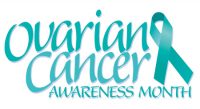
Ovarian Cancer Awareness Month
- Clarion Top News
- Wednesday, 09 September 2020 11:17

by Martha Smith
There are 365 days in a year and about 525,600 minutes. This year alone, an estimated 14,000 women will pass away from ovarian cancer. If we do the math and distribute that number throughout the year, that is one mother, daughter, sister and friend, lost to this insidious disease every 38 minutes. Every woman, regardless of age or history, is at risk.
Some of us have lost someone to this cancer. We can trace back through the days to when the first symptoms started showing up. Things we overlooked, but later could see there was clearly something very wrong. Things like, “She picked at her food,” or “She just didn’t feel good anymore,” or “She didn’t get around as well as she used to,” or “She seemed to gain/lose weight overnight,” or “I don’t understand. She went every year for her exam.” (No, a pap test does not detect ovarian cancer; it detects cervical cancer.)
Ovarian cancer is referred to as the silent killer because usually by the time symptoms present themselves, it’s an indicator the cancer has already spread to other parts of the body and is causing problems. Over half of ovarian cancer diagnoses are discovered in late stages. In cancer terms, the later the stage, the more the disease is prevalent and detected throughout the body. Ovarian cancer is one of the most difficult to find and the most commonly misdiagnosed because the tell-tale indicators can be a long list of other possibilities.
Symptoms such as bloating, pelvic or abdominal pain, trouble eating or feeling full quickly, feeling the need to urinate urgently often can be overlooked as something else. Other symptoms to look out for are fatigue, upset stomach or heartburn and back pain. All of these symptoms could be something else, something harmless, something mundane and taken care of with an antacid.
According to ovarian.org, “When the symptoms are persistent, when they do not resolve with normal interventions, it is imperative for a woman to see her doctor. Persistence of symptoms is key, because these signs and symptoms of ovarian cancer have been described as vague or silent. Only approximately 15% of ovarian cancer is diagnosed in the early stages.”
So, what can you do? Know your doctor. Don’t have one yet? Get one and get screened on a regular basis. The next step? Know your body. Be familiar with how you feel and when. The sooner you feel or notice something is wrong or different, the sooner the problem can be found, raising your survival rate substantially.
Know your family history. About 15% of ovarian cancer cases can be linked to genetics. Mutations in the genes BRCA1 and BRCA2 have been found to be responsible for a shocking number of breast and ovarian cancer diagnoses.
Ovarian.org states, “Carriers of a BRCA gene mutation face a lifetime risk of ovarian cancer between 10-60%.”
Those who test positive for the BRCA mutations are also encouraged to follow a more stringent screening routine, so know the terminology. If you carry the mutations, know the tests that can help detect ovarian cancer, and show up to your appointment armed with information. A thorough pelvic exam should be ordered, along with an internal ultrasound. The CA-125 blood test should also be requested. CA-125 is a protein that ovarian cancer cells produce and is detectable through labs. Although CA-125 is not always a key marker for the disease because conditions in the ovaries can cause an increase in the protein levels, women at risk for ovarian cancer should be tested regularly for this protein.
Most importantly, be your own fierce advocate. Know that if your doctor won’t listen when you speak up, there is another doctor down the road who will. Keep speaking up until you are taken seriously, and don’t be afraid to be assertive and demand answers. This is your life. Call your mothers and remind them. Teach your daughters. Support your sisters, and encourage them to be consistent and self-aware. Speak up when an opportunity presents itself – and speak up when it doesn’t.
Log on to ovarian.org and read up on this disease and how you, as a woman, can fight it.

